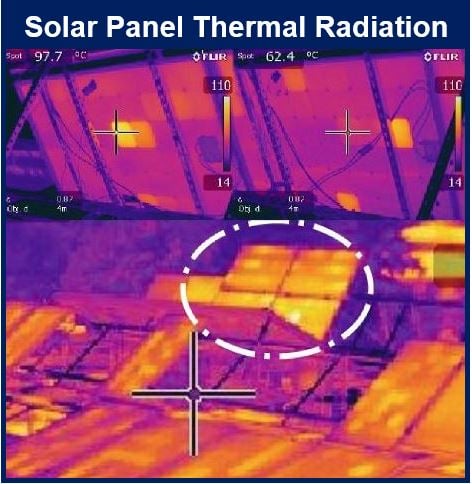Researchers in the US and Canada have found a way to get more sunshine on the solar panels in order to raise output by at least 30%. The more we raise solar panel system output, the more competitive this form of renewable energy becomes compared to nuclear power or gas-fired electricity generation.
Associate professor Joshua Pearce, who works at Michigan Technological University’s Department Of Materials Science And Engineering, said:
“We expend a lot of blood, sweat and tears to make solar panels as efficient as possible. We work so hard to get a fraction of a percent increase on the module level; double digit returns on the systems level was relatively easy.”
 Thermal radiation readings on panels help the researchers better understand ways to improve low-concentration photovoltaic systems. (Image: Michigan Tech)
Thermal radiation readings on panels help the researchers better understand ways to improve low-concentration photovoltaic systems. (Image: Michigan Tech)
Prof. Pearce, who worked alongside a team of scientists from Queen’s University in Canada, explains that research concentrated on the system instead of the individual panels, mainly because there is a huge amount of wasted space in ground-mounted solar panel arrays today.
Light in spaces between panels is lost
The iconic flat-faced solar panels that are used in large-scale utility solar farms are placed far apart from each other to ensure there is no shading.
Much of the light that falls on a photovoltaic system, which sends electricity into the grid, is not used – any light that hits the space between the rows of panels is lost.
There is a simple solution to this, says Prof. Pearce. If you place reflectors in those empty spaces, sunlight bounces back onto the panels.
Panels are generally warranted for twenty to thirty years. The warranties are usually only valid under certain circumstances.
Prof. Pearce said:
“Panels are usually warranted for 20 to 30 years. If you’re putting more sunlight on the panel with a reflector, you will have greater temperature swings and non-uniform illumination, but simple optics makes wrong predictions on the effect.”
 Joshua Pearce is Associate Professor, Materials Science and Engineering and Associate Professor, Electrical and Computer Engineering at Michigan Tech. (Image: theinstitute.ieee.org. Credit: Sarah Bird/Michigan Technological University)
Joshua Pearce is Associate Professor, Materials Science and Engineering and Associate Professor, Electrical and Computer Engineering at Michigan Tech. (Image: theinstitute.ieee.org. Credit: Sarah Bird/Michigan Technological University)
Using mathematical equations to predict reflected light
Using reflectors currently voids warranties for solar panels. However, Prof. Pearce and team say they have found a way to predict the effects using a set of math equations called bi-directional reflectance function (BDRF).
BDRF is commonly used in movies and videogames to create more realistic computer-generated imagery (CGI) characters and scenes.
BDRF equations describes how light bounces off rough surfaces and predicts how it will scatter, creating indirect brightening and shadows.
In this study, the scientists created a BDRF model that could predict the amount of sunlight that would bounce off a reflector and where on the array it would shine.
Prof. Pearce said:
“Real surfaces do not necessarily behave like perfect mirrors, even if they look like it. So we applied [BDRF] models to these materials, which scatter the light instead.”
Reflectors increase solar panel system output
By showing how light is scattered after bouncing off the reflectors, the team started to take the risk out of using reflectors with solar panels. But even better, the reflectors significantly increase solar panel system output.
The mathematics behind this is complicated, the authors explained. They wanted to “validate the predictive model, so the solar industry could start using our equations to design better solar farms.”
So they took their model into the field and carried out an experiment on Canada’s Open Solar Outdoors Testing Field in Kingston, Ontario. The results were much better than the scientists had expected.
For standard solar panels, not tilted at the best angle for latitude, there was an up to 45% increase in efficiency. When optimally tiled, efficiency increased by 18%. Simulations have demonstrated that this could be raised to 30% if better reflectors are used.
Prof. Pearce said:
“We expend a lot of blood, sweat and tears to make solar panels as efficient as possible. We work so hard to get a fraction of a percent increase on the module level; double digit returns on the systems level was relatively easy.”
“Solar farms are already beating antiquated coal technology on cost all over the US. There are more solar workers than coal workers now as both in the U.S. and Canada, coal plants are being shut down for cheaper and more environmentally-friendly solar. This just offers to sweeten the economic returns for solar farm investors.”
“The main goal here was to hand the solar farm developers the data needed on a silver platter, which they can then use to modify their farms and crank up their output and revenue by about a third.”
Citation: “Photovoltaic System Performance Enhancement With Nontracking Planar Concentrators: Experimental Results and Bidirectional Reflectance Function (BDRF)-Based Modeling,” Andrews, R.W., Pollard, A. and Pearce, J.M. IEEE Journal of Photovoltaics. October 7th, 2015. DOI: 10.1109/JPHOTOV.2015.2478064.
